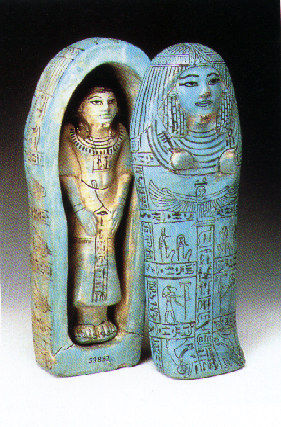
Faience Egyptian Shabti and Sarcophagus
New Kingdom, 1300-1000 BCE, inscribed for Amenmes
ART 198 - HISTORY OF WORLD CERAMICS
| Made from Pre-Dynastic times forward, faience is a quartz (silicaceous) clay body, that, when fired, becomes vitreous, developing a 'self-glazed' surface. Also known as Egyptian Paste, this clay was used to create beads, jewelry, vessels for precious oils and perfumes, and figurines. The best examples are the shabti, funeral statues made to provide the deceased with servants in the afterlife. Often, copper was present as an impurity in the clay, causing the development of a lovely turquoise blue glaze. Manganese was also used, with the resulting purplish glaze appearing during the firing. The faience clay body is not plastic, so was little used for wheel throwing, but commonly used, as here, for objects that were made in press molds. This figure was found in the tomb of Amenmes, and was to ensure that he was well cared for in his afterlife. One wonders if the slaves also had their own shabti to serve them in their after lives! | Faience Egyptian Shabti and Sarcophagus New Kingdom, 1300-1000 BCE, inscribed for Amenmes |
|
|